Reviews
Review: Assassin’s Creed: Revelations
November 17, 2011, Author: Ray Willmott
Synchronising three timelines together into one story is a difficult narrative arc to get right. Some writers struggle trying to convey one character’s journey, let alone trying to handle three adventures at the same time. It’s a bold undertaking from Ubisoft, not only trying to draw conclusion to the story of Ezio Auditore, but to allow Desmond Miles’ adventures to continue, whilst revealing new secrets and details about the life of the original Assassin, Altair.
Yet, here we have Revelations, confident that it can juggle such a responsibility, preparing us for the ultimate experience. Is this the definitive Assassin’s Creed game that Ubisoft have been striving to make since the very beginning, or is this a series that should disappear back into the shadows from whence it came?
The Past is the Present is the future
Revelations is set several years after the events of Brotherhood. Ezio is a lot older, but he is a more disciplined assassin. While he is still flamboyant and charismatic, he is also more reserved, and wiser. Ezio has tasted blood; he has orchestrated civil war with his acts of revolution and defiance, but he has remained true to his purpose. Revelations finds our familiar protagonist starting his journey in Masyaf, the grounds of the old Assassins Stronghold, made famous by the exploits of Altair.
Ezio has discovered that Altair has hidden an ancient artefact deep in the stronghold, which could end the war between Templars and Assassins permanently, but in order to access it, Ezio must locate several hidden keys, which are scattered around Constantinople. The game offers a unique insight into Altair’s history, with Ezio reliving his memories through relics of the First Civilisation. These sequences will help synchronise a link between Altair and Ezio, but also reveal key secrets about the artefact, and its legacy.
In-between all this, we switch back to Desmond Miles who is trapped in an Animus Limbo, known as the Black Room. Desmond’s mind has been shattered from continued use of the Animus, and he has lost all grasp of what is real. In this sort of dream-like state, Desmond will need to learn of the relationship he shares with Ezio and Altair, discovering his own lineage, but also learning more about his past, where he grew up and how he came to this point. Delicately, Desmond will need to piece his mind back together, re-learning things he already knew, and discovering hidden truths that had been repressed to the recesses of his mind.
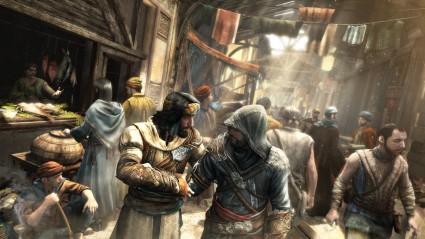
The story here is as good as ever...
A knife in the back is worth two in the face
I could go on for pages detailing the amount of changes Ubisoft have implemented into Revelations. You could argue that many of these changes are subtle, but that doesn’t make them any less significant.
One of the biggest changes is the addition of the Hookblade. This is an upgrade Ezio applies to his arm, which allows him to climb higher than ever. It improves his reach, and if Ezio is falling from an incredibly high height, he can use the hook to stick himself to a wall, preventing him from shattering every bone in his body. The Hookblade will also allow Ezio to use Ziplines which can be found all over Constantinople. These allow Ezio to scale rooftops with greater ease than ever, and present equally exciting assassination opportunities. You can even glide onto a Zipline while using your parachute for extra finesse.
Revelations also makes much more of the Assassins system which was introduced in Brotherhood. You can still send your Assassins on missions all over the world, whether you want them to cause a riot or go on espionage missions, and their level and the difficulty rating of that mission, will depend on the % success rate they will have. What’s different this year is that once you’ve acquired a territory, you have to fight to keep it by investing in that territory. This will require some initial investment of your own to help rebuild the city, however, overtime, your work in these other cities will pay off and contribute to your overall bank balance, allowing you more money to buy out shops, and monuments.
This is also a good way to develop your Assassin’s rank and build them towards being a Master Assassin. In Revelations, you can also acquire Assassin Dens, where you can appoint your protégé’s as leaders of these dens. Once you’ve done this, they will watch that area of the city, strengthening an Assassin Presence there. They will also present you with missions from time to time, telling you about the goings on in that region.
If you’re not doing a good job of upholding the cities you’ve fought to claim, then the Templars will fight back, and you will have to defend your newly acquired domain via a Strategy mini-game. As Ezio, you will assign Assassin leaders to rooftops, surrounding them with Archers and Riflemen, and then place barricades down in front of the entrance of the City. All this is done to repel the impending Templar invasion, whether they’re using mere infantry or battering rams to reach their objective.
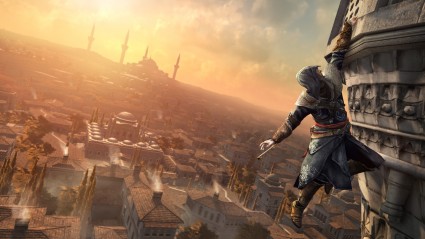
The hookblade is a bit like Ezio's own Swiss Army Knife... Useful for everything!
You can also call for bomb-strikes to rain down on the Templars (Renaissance Style Air-Strikes, CoD fans..) to help gain that extra advantage in battle. These mini-games will regularly pop up the deeper you get into the game. Depending on if you like them or not, this can certainly be a point of contention for some, and makes for an unusual change of pace for an Assassin’s Creed game, a series which never directly draws your attention to one particular area of its playpen, but always presents you with plenty of opportunities.
With bombs, however, the series meets its biggest change. Assassins Creed has been primarily a sneak and kill game with hidden blades, swords and maces, but this year, you can apply an even more unique approach to battle. The player will have the choice of using Lethal, Tactical or Distraction bombs, each bomb made up of three separate components. Firstly, you need to decide if the bomb will have a small, medium or large radius. You then need to decide the type of fuse it will have, whether it explodes on impact, or if it’s a sticky bomb that takes five seconds to detonate.
The final ingredient varies greatly, and essentially defines the bomb, whether you’re using smoke, poison or even lamb’s blood. Ingredients are found all over the world, mostly in chests and on people’s bodies, but you can also buy components from black market vendors, and, if you’ve taken over one area of the world, your assassins will find new components in other cities that will help you devise bombs never before seen in Constantinople.
While the possibilities aren’t endless, there’s a great variety available to you. You can have a Tactical Bomb that explodes instantly on your enemies, covering them in lambs blood and making them vulnerable to your attack. You can also create a three-second small radius bomb that spews out gold pieces around an army of guards, causing beggars and citizens to go crazy, and shower the guards with a stampede of money-driven maniacs.
The way Assassin’s Creed can be played, the way you approach your targets, and manoeuvres you can use to escape combat have never offered such creative freedom. That being said, despite how many combinations Ubi have been touting for Revelations, it does seem like you are bound to several different styles, before you’re essentially replicating the same bombs. Still, Revelations feels wholly different to Brotherhood, and any other Creed game, because of these changes.
Perhaps equally groundbreaking for the series are Desmond’s missions. For the first time, you will be playing levels as Desmond from a First Person Perspective. The best way to describe these missions would be to put Portal and Knightmare into a room made up of Tron’s Grid and mix them all together. During these missions, Desmond learns more about his past life, starting off on a farm with his parents, learning about his life when he was part of the assassins and leading him towards the man he has become today.
These missions are available to Desmond through Animus Island, and are only available if you collect Animus fragments as Ezio throughout the game. The only way for you to see Desmond’s missions in their entirety is to collect every single fragment, making these missions entirely optional, but still an integral part of the Revelations story. Unfortunately, while these missions are worth pursuing for the story, the general mechanics that make up the levels become tedious very quickly. The premise seems a good idea in theory, but with you essentially creating pathways for yourself out of building blocks, it’s not the most creative thing Ubisoft could have done with the concept.
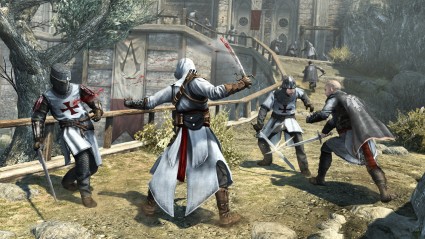
Yus! Altair is back and even more awesome!
Assassin’s Creed is a game that has always prided itself on collectibles and the amount of them, but this year, never has it felt so imperative to get them, nor have they ever felt more a part of the story. While there are less of them than last year’s Brotherhood, in Revelations they definitely bear more significance.
Aside from the multiplayer, (which I’ll be detailing in a little while..) the other changes within Revelations are much more subtle, but still very prominent. It seems Ubisoft have tried to identify any elements of Assassin’s Creed that people felt were shallow and improved on them, even down to the loading screens. Now you can actually take part in mini-training exercises while the game is loading between sequences, instead of just having your character wander around a computer grid.
Personally, I feel this is a much more suitable addition to the series, over Brotherhood’s separate Animus Training System, which just felt tacked on, and redundant after you unlocked the only achievement linked to it. Creed’s loading screens have always been a bit demanding for the impatient gamer, but Revelations certainly helps allay those issues.
You’ll also have to contend with Templars disguised as citizens grabbing you from behind trying to stab you in the back. A lot of the time, you will probably see them coming, but occasionally; especially if you’re stopping to catch your breath, they’ll catch you completely unawares and really put you in a life or death situation. After years of fighting the system, Ezio is a marked man, and just as he has evolved his tactics in battle, so have his adversaries. Also, for the first time, Ezio won’t just be able to run away from his attackers. This year, they have muskets and can fire at Ezio from a long-range, slowing him right down, and injuring him in the process. Yet another reason for you to start evolving your assassin tactics.
Frankly, I could keep going on about what is different and improved, such as the Second Weapon Wheel, the variety offered by the Altair missions, automatic walking within crowds, or using the hookblade to trip up enemies in battle. I’m just giving you a taster of how much Ubisoft have invested in Revelations, showing that this isn’t just a simple Assassin’s Creed 2.75.
I do feel Ubisoft could and should have made more of Ezio’s age in the game, and by not doing that, they’ve missed an excellent opportunity. Frankly, the only way to tell he is old via means of gameplay is by spinning the camera around to his face and staring at it. In terms of getting about, Ezio has never been more dexterous. It’s certainly an area Konami are familiar with, and were able to put to good use in Metal Gear Solid 4 with Solid Snake, but in Revelations, it’s all but been ignored.
Another surprising omission is the lack of horses. I became quite used to using them in Brotherhood as the map was quite spacious, but here, it seems that the Ziplines have been put in place instead, and while they are quite cool, they’re not really a suitable alternative. These are two glaring issues I found with Revelations, that didn’t spoil my enjoyment, but certainly would have added to the overall experience.
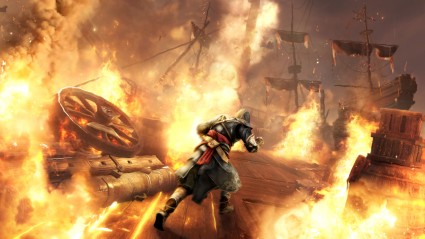
Watch the world burn!
Gliding with the eagles
Assassin’s Creed has reached that point in the series where gamers are starting to notice its aging engine. Frankly, this is largely in part due to the frequency of Creed releases. As the series has been released annually since 2009, it hasn’t presented the development team much of a chance to improve upon the existing toolset. That being said, Revelations makes full use of the Creed Engine, and still manages to showcase its true beauty.
Some of the sunset and dawn sequences are breathtaking, looking down at an evolving city from a high point can still cause you gasp, and free-falling from the highest point straight into a haystack still causes my palms to clam up and my heart to race. It’s an old engine, but it still has life left in it.
Suitable then, as Ezio is an aging protagonist, depicted as much via his aging face, and body language. Ubisoft have done an excellent job in showing the difference in look of our protagonist, giving off less of a boytoy image, and more of a serious, hardened demeanour. Yet, Ubi have kept him very faithful to the Ezio we know, still able to command fealty and respect, but remains eager to learn, harnessing his techniques and learning new ones.
Constantinople is a beautiful location for Revelations, defined by its rich districts, as much as its poor. There’s a real feeling of progression throughout the game, and a variety like never before, which sees Ezio travelling between islands via ferry in order to reach his objectives. Revelations isn’t a game that sits comfortably, relaxing back on its laurels; it makes full use of the enormous map its created for itself, and isn’t afraid to revisit areas in the game just because it has already been there. Revelations will take you on a glorious journey, but never grows weary for all of its tooing and froing.
Under cloak and dagger, no one can hear you scream
Creed still manages to sound very authentic to the locations it presents. Constantinople is a thriving city that comes alive when you visit the bazaar, just as it quietens when you explore the outer regions through open fields. You’ll always feel as if you’re in a separate part of the city, whether it’s at a party or a traveller encampment, there’s not a one dimensional feel backing Revelations in the slightest, and the game is very aware of where you’re situated.
The voice acting is as excellent as ever. Ezio still has biting wit to accompany his aging tone, but he is a much more methodical warrior, aware of his position, and equally protective of those he has taken under his wing, or who have shown him kindness. There’s still a very clear chemistry between Ezio and those who he shares his allegiance with. There’s even time for a new love interest, which Ezio certainly doesn’t seem adverse to.
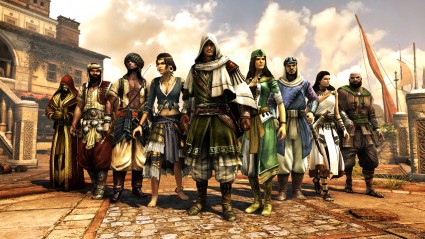
The multiplayer posse!
Out of the shadows, into the fray
Brotherhood did the impossible and introduced multiplayer gaming to Assassin’s Creed, something nobody thought was possible. The craziest part of all? It actually worked. Sure, it needed some fine-tuning and tweaking and a hook to keep people playing, but Ubisoft did their job.
With Revelations, they’ve gone to the next level. As you may have heard by now, the multiplayer in Revelations contains a story mode which is focused around Abstergo and your development within the corporation from the rank of initiate. As you grow and develop within Abstergo, so you learn more about the company, and gain greater access to their inner vault of information. While this isn’t as intricate a narrative as the SP portion of the game, Ubisoft have done a commendable job in creating an interesting insight into, what has been to this point, a somewhat mysterious organisation.
Within Revelations, you can customise the look of your Assassin, create clans, branding them with a coat of arms. There are a set of default items you get from the beginning, but you can also earn more by making your way through the single-player game. This will unlock new items within the multiplayer, and enable you to purchase them through the Abstergo store with Abstergo credits. Credits, which can be earned by performing amicably in multiplayer, or again, making progress through the single-player game.
Also, for the first time, you can access the friend hub and view your friend’s individual Abstergo Cards (similar to CoD Player Tags). Here, you can issue challenges to your friends and interact with them throughout the multiplayer. You can also beat your friends score on certain areas of multiplayer, whether it is in the training missions or by actually competing online. You can also go straight to their gamercard, and take on any challenges they set when they’ve beaten your scores.
Familiar modes return such as Deathmatch, which see you as both predator and prey. You’re given a contract through the ten minute time span, and you have to identify the player from the portrait given to you in the top right hand corner of the screen. You can tell when you’re in close vicinity of the target, by seeing a blue outline outside of the character portrait. This means you’re in their line of sight, and the time to ready your blades for assassination draws near.
The point of Deathmatch is get the most stylish kill possible, and added points are given for catching your opponent completely unawares, whether you’re blending in with a crowd or descending on them from on high. However, you also need to watch your back, as another player will have a contract out on you, so while you need to focus on your target, you need to make sure that you’re not leaving yourself exposed. You are made aware of a predator’s proximity to you by the sound of whispers, the louder they are, the closer they are. This adds an all-important emphasis on sound in the deathmatch mode, which, while always important, has perhaps never been so significant.
There are also new modes to explore here such as a variation on Capture the Flag known as Artefact Assault, where the objective is to grab an artefact from the opposing team’s territory and return it to your own, with a focus on evasion, rather than assassinating your enemies. There are also story-orientated quests available within the multiplayer, and those are unlocked as you gain higher ranking.
The depth of multiplayer in Revelations is breath-taking, and does nothing but show great promise for the future of the mode in the Assassin’s Creed series.
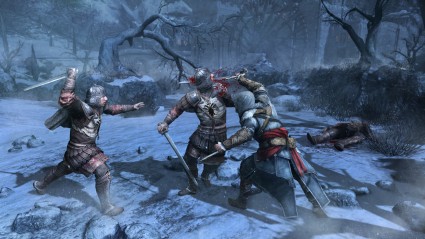
Combat is as fun as ever!
The final journey
Some would argue Ezio was ready to end his journey after Brotherhood, I know, as I was one of them. However, after playing Revelations, I can see I was wrong. Ubisoft still have a story to tell, and they do a magnificent job of it, somehow intersecting three timelines together and pulling it off marvellously. That being said, this does feel like a natural ending for Ezio, and I feel that the series is definitely ready to move on to something different in 2012.
When playing Arkham City last month, while I enjoyed the whole experience, I kept thinking of things Rocksteady could have done to enhance the game, and make it even better. With Assassin’s Creed, I am always amazed at what they do implement, ideas I never expect to see, and how much I end up enjoying them, and finding I can’t imagine my game without them. I’m utterly inspired by how bold and unafraid Ubisoft are to tweak and try new things with this franchise.
True, sometimes these experiments don’t work, and there are certainly elements of Revelations that could do with a new lick of paint, or being scrapped altogether, but what we do have is, yet again, another excellent value for money package that continues to surprise and deliver. Coming to Revelations and seeing Ezio like this was like visiting an old friend, knowing it was the last time I would ever see him, but relishing every moment all the same.
Platforms: PC, PS3, Xbox 360 | Tagged Altair, Assassan's, Assassins Creed, assassins creed revelations, Blade, Brotherhood, Ezio, Multiplayer



